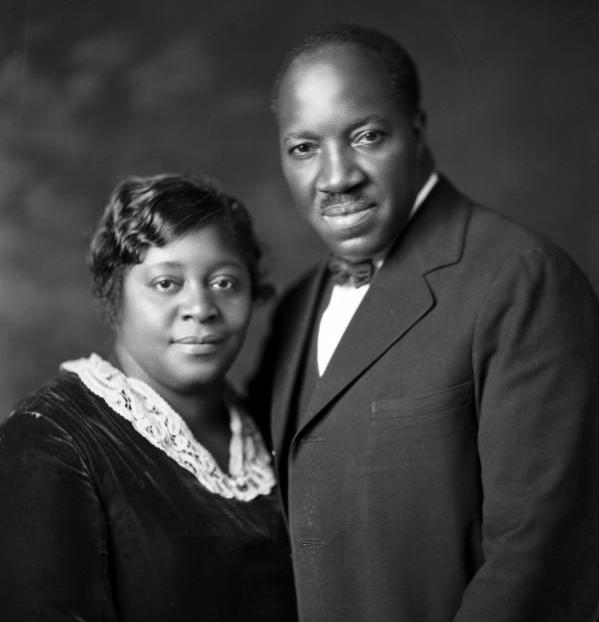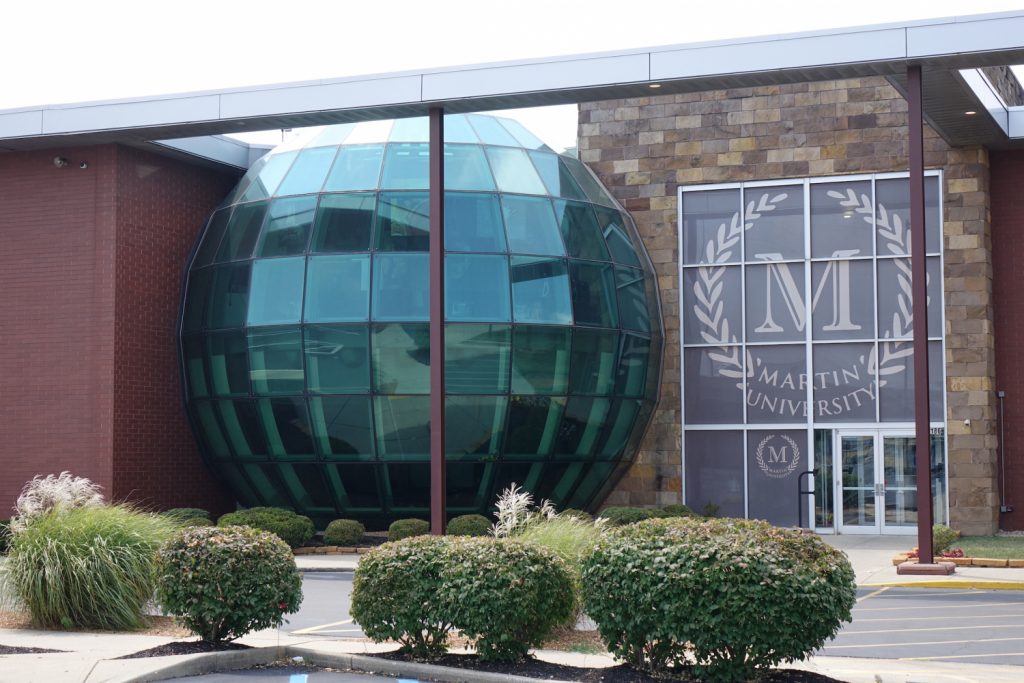Churches have long occupied a central position within the Indianapolis African-American community. As the first institution that the Black community controlled exclusively, African-American churches met religious needs, supplied community aid, fought for African-American rights, and allowed members to develop leadership skills and a sense of self-worth that often could be found nowhere else.
The founding and demographic trends of African-American churches in Indianapolis have reflected the growing diversity and dispersion of the local Black population. As early as the 1830s, African-American churchgoers attended white Methodist and Baptist churches but were segregated from the rest of the congregation during services and were unable to participate in church governance or congregational life.
The first African-American churches in Indianapolis were Methodist and Baptist congregations founded by visiting Black missionaries in the neighborhood. The congregation that became began in 1836 as part of the missionary tour of the West by Rev. Paul Quinn. was organized in 1846 by Rev. Charles Sachel. Both Quinn and Sachel were Cincinnati-based missionaries.

After the Civil War, when southern African-Americans moved to Indianapolis in large numbers, both the AME and Baptist denominations established new churches. AME congregations included Allen Chapel AME (1886) and Simpson Chapel (1875). Another branch of Methodism, the AME Zion church, appeared in Indianapolis after of Black missionaries from New Albany, Indiana, organized Jones Tabernacle in 1872, followed by Lovely Lane Church (later St. Mark AME Zion) in 1886. Since many of the southern migrants were already Baptist, Black Baptist churches soon claimed dominance in the number of churches and members. By 1900, the number of Baptist churches had grown to 18, including Olivet (1867), (1872), New Bethel (1874), Corinthian (1881), and Barnes Chapel (1887).
The influx of southern Black migrants caused many white denominations to found mission churches for their “colored brethren.” The first denomination to do so was Disciples of Christ, which in 1866 sponsored a mission and school led by white lay leaders. The congregation eventually became Second Christian (later known as ) and so attracted its own Black minister. By the 1880s, other white denominations had followed this lead. In 1881 local Presbyterians dissolved a white congregation, Ninth Presbyterian, and resurrected it as a Black mission. Two white Episcopal congregations established a mission for African-Americans in 1888, which later became St. Philip’s, and Catholics established a church school for African-American children in 1892 named St. Ann’s.

The number of Black Methodist and Baptist congregations continued to grow and diversify during the 20th century. By 1920 there were 10 AME and 7 AME Zion churches. Both denominations had some of the largest Black congregations in the city but had also reached their zenith in numbers of churches. The Colored Methodist Episcopal Church (CME), a southern brand of Methodism now known as the Christian Methodist Episcopal church, made its local appearance with the founding of Philip’s Temple CME in 1907 and Trinity CCME in 1924.
With over 30 churches by 1920, Black Baptists began to experience divisions within their fellowship. A split nationally among African-Amercian Baptists resulted locally in the establishment of two separate districts. In addition, three Freewill Baptist congregations were founded. still, the number of Baptist congregations continued to rise, reaching over 60 churches by 1936–the highest number of any one denomination in the city at the time. In 1943 the Central Baptist Theological Seminary was founded and located at South Calvary Baptist.

Indianapolis became the site of a new African-American Pentecostal denomination by the 1920s. founded what became Christ Temple Apostolic Church, an integrated Pentecostal congregation, in 1909. The church grew rapidly despite harassment by segregationist elements. When a national split among Pentecostals occurred in 1919, Haywood became presiding bishop of the predominately Black Pentecostal Assemblies of the World denomination, which located its headquarters in the city.
White denominations continued to establish segregated mission churches well into the 20th century. United Presbyterians sponsored Witherspoon, an all-Black congregation in 1907, and white Presbyterians renewed their mission efforts by establishing Senate Avenue Presbyterian (later Sutherland and now Immanuel) in 1908. The Roman Catholic church established as a segregated Black parish with a white priest in 1919. With sympathetic leadership during the 1930s, the church school grew past capacity, and Black congregants began to be accepted at several other parishes. Lutherans sponsored a mission in 1938 which originally met at the . Both the First Colored Nazarene Church and First Free Christian (Disciples of Christ) were also organized during this time, but neither survived.
As the local African-American population grew beyond its original neighborhood boundaries after , old congregations resettled farther north and new churches appeared. The more evangelical churches benefited the most from the population growth. While the AME and AME Zion denominations remained relatively stable in number, the number of CME congregations had grown to 13 as of the early 1990s. The number of Black Baptist churches multiplied, and by 1960, there were 108 local congregations. As of the early 1990s, there three separate associations of Black Baptists in Indianapolis, representing over 180 churches, and an unknown number of independent storefront Baptist congregations.
The numbers of African-American Catholics have increased since World War II, especially since the 1970s. By the early 1990s there were three predominantly Black congregations – St. Rita, St. Bridget, and Holy Angels – in addition to several other parishes with significant numbers of Black congregants. Most of these parishes had African-American priests and nuns and were seeking to be better represented in the church hierarchy and to express their culture within Catholic traditions.
The second half of the 20th century witnessed a large increase in small, independent and storefront churches within the African-American community. As the Black population moved north into neighborhoods abandoned by whites, some churches began to purchase the former buildings of white congregations or were able to build their own. However, under the pressure of needed services and low resources, many fledgling congregations resorted to using storefront properties. Already by 1959 there were almost as many storefront churches in Indianapolis as established denominational churches.
A new form of African-American worship, Islam, arrived in Indianapolis after World War II. African-American Muslim chapters were first organized in the 1940s, and by the late 1950s a significant group was allied with the . Four mosques served the Indianapolis area in the early 1990s, and the was headquartered in nearby Plainfield.

As is true of all mainstream denominations and churches, African-American churches have always provided their congregants with spiritual sustenance and a world view. In a society where African-Americans have been enslaved or suffered discrimination, Black ministers have preached eternal salvation, thus making present life more bearable. Black churches and ministers have also consistently supported education, temperance, personal responsibility, and civil rights. Embracing all these ideas, local churches have traditionally sponsored an annual Emancipation Day celebration including a service and a parade. While this tradition lapsed during the early 20th century, it was revived in the 1940s.
Church buildings have traditionally provided space in which Black community groups could meet and venues for social and cultural activities. Early African-American churches conducted revivals and quarterly Love Feasts and had sickness and burial provisions for their members. Many congregations sponsored benevolent societies, such Paul Quinn Missionary Society, as well as self-improvement, debating, and literary clubs, and temperance societies. Churchwomen’s groups distributed food and clothing, organized and supported the for the aged, supervised young people’s groups, raised money for church facilities and programming, hosted national speakers and conducted vacation Bible schools. The local chapter and the organized and met at Bethel AME. Other churches hosted community-wide social activities, speakers, and denominational conferences. Today local community groups hold meetings and sponsor Black History Month activities at many area Black churches.
Education has always been a high priority of African-American churches. Since African-Americans were not allowed in local schools until the 1870s, churches offered classes to teach adults and children to read and write. In the 20th century, African-American churches supported educational scholarships and started local colleges including Central Baptist Theological Seminary (1943) and (1969).

African-American churches often helped rural Black residents assimilate to urban conditions through social welfare programs. Churches provided informal and later, organized day care, employment services, housing assistance, food and clothing, as well as general health and welfare programs. During the 1950s and 1960s, many local churches supported the efforts of the NAACP and the . Additionally, several ministers were heavily involved in organizing the local branches of Operation Breadbasket and the Southern Christian Leadership Conference.
While African-American churches have historically struggled with lack of financial and community resources and powerlessness outside the African-American community, they have provided sustenance and aid to their members and the community, as well as leadership in gaining civil rights and personal freedoms. Even today, when other institutions have taken over many church functions, a large number of the city’s African-American residents still turn to Black churches in times of crisis or need.
*Note: This entry is from the original print edition of the Encyclopedia of Indianapolis (1994). We are currently seeking an individual with knowledge of this topic to update this entry.
CITE THIS ENTRY
APA:
Hale, M. D. (1994). African American Churches. Encyclopedia of Indianapolis. Retrieved Jan 5, 2026, from https://indyencyclopedia.org/african-american-churches/.
MLA:
Hale, Michelle D. “African American Churches.” Encyclopedia of Indianapolis, 1994, https://indyencyclopedia.org/african-american-churches/. Accessed 5 Jan 2026.
Chicago:
Hale, Michelle D. “African American Churches.” Encyclopedia of Indianapolis, 1994. Accessed Jan 5, 2026. https://indyencyclopedia.org/african-american-churches/.

Help improve this entry
Contribute information, offer corrections, suggest images.
You can also recommend new entries related to this topic.
